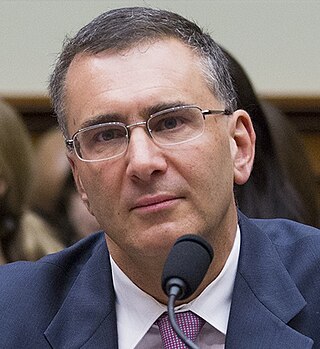Related Research Articles

The American Medical Association (AMA) is an American professional association and lobbying group of physicians and medical students. Founded in 1847, it is headquartered in Chicago, Illinois. Membership was 271,660 in 2022.

JAMA (The Journal of the American Medical Association) is a peer-reviewed medical journal published 48 times a year by the American Medical Association. It publishes original research, reviews, and editorials covering all aspects of biomedicine. The journal was established in 1883 with Nathan Smith Davis as the founding editor. Kirsten Bibbins-Domingo of the University of California San Francisco became the journal editor-in-chief on July 1, 2022, succeeding Howard Bauchner of Boston University.
Families USA is a nonprofit, nonpartisan consumer health advocacy and policy organization.

John C. Goodman is president and CEO of the Goodman institute for Public Policy Research, a think tank focused on public policy issues. He was the founding chief executive of the National Center for Policy Analysis, which operated from 1982 to 2017. He is a senior fellow at the Independent Institute. The Wall Street Journal and The National Journal have called Goodman the "father of Health Savings Accounts."

Jonathan Holmes Gruber is an American professor of economics at the Massachusetts Institute of Technology, where he has taught since 1992. He is also the director of the Health Care Program at the National Bureau of Economic Research, where he is a research associate. An associate editor of both the Journal of Public Economics and the Journal of Health Economics, Gruber has been heavily involved in crafting public health policy.
Healthcare reform in the United States has a long history. Reforms have often been proposed but have rarely been accomplished. In 2010, landmark reform was passed through two federal statutes: the Patient Protection and Affordable Care Act (PPACA), signed March 23, 2010, and the Health Care and Education Reconciliation Act of 2010, which amended the PPACA and became law on March 30, 2010.

In the United States, health insurance coverage is provided by several public and private sources. During 2019, the U.S. population overall was approximately 330 million, with 59 million people 65 years of age and over covered by the federal Medicare program. The 273 million non-institutionalized persons under age 65 either obtained their coverage from employer-based or non-employer based sources, or were uninsured. During the year 2019, 89% of the non-institutionalized population had health insurance coverage. Separately, approximately 12 million military personnel received coverage through the Veteran's Administration and Military Health System.

Andrew M. Slavitt is an American businessman and healthcare advisor who served as the acting administrator of the Centers for Medicare and Medicaid Services from March 2015 to January 2017 and as a temporary Senior Advisor to the COVID-19 Response Coordinator in the Biden administration. A leader of the team that helped to repair the healthcare.gov website after its initial rollout, he was nominated by Barack Obama to run CMS in July 2015. In January 2021, Slavitt accepted a temporary role as Senior Pandemic Advisor to President Joe Biden’s COVID-19 pandemic response team. He stepped down from that role in June 2021.
A health insurance mandate is either an employer or individual mandate to obtain private health insurance instead of a national health insurance plan.

The Affordable Care Act (ACA), formally known as the Patient Protection and Affordable Care Act (PPACA) and colloquially as Obamacare, is a landmark U.S. federal statute enacted by the 111th United States Congress and signed into law by President Barack Obama on March 23, 2010. Together with the Health Care and Education Reconciliation Act of 2010 amendment, it represents the U.S. healthcare system's most significant regulatory overhaul and expansion of coverage since the enactment of Medicare and Medicaid in 1965. Most of the act's provisions are still in effect.
A contraceptive mandate is a government regulation or law that requires health insurers, or employers that provide their employees with health insurance, to cover some contraceptive costs in their health insurance plans.
Since the passage of the Affordable Care Act (ACA), there have been numerous actions in federal courts to challenge the constitutionality of the legislation. They include challenges by states against the ACA, reactions from legal experts with respect to its constitutionality, several federal court rulings on the ACA's constitutionality, the final ruling on the constitutionality of the legislation by the U.S. Supreme Court in National Federation of Independent Business v. Sebelius, and notable subsequent lawsuits challenging the ACA. The Supreme Court upheld ACA for a third time in a June 2021 decision.

The Authority for Mandate Delay Act is a bill that would amend the Patient Protection and Affordable Care Act "to delay until 2015 enforcement of requirements that large employers offer their full-time employees the opportunity to enroll in minimum essential coverage." The bill was introduced into the United States House of Representatives during the 113th United States Congress.
The Affordable Care Act (ACA) is divided into 10 titles and contains provisions that became effective immediately, 90 days after enactment, and six months after enactment, as well as provisions phased in through to 2020. Below are some of the key provisions of the ACA. For simplicity, the amendments in the Health Care and Education Reconciliation Act of 2010 are integrated into this timeline.
United States House of Representatives v. Azar, et al. was a lawsuit in which the United States House of Representatives sued departments and officials within the executive branch, asserting that President Barack Obama acted illegally in his implementation of the Patient Protection and Affordable Care Act. The lawsuit was touted by House Speaker John Boehner, and asserted that President Obama exceeded his constitutional authority in delaying the implementation of the employer mandate of the Affordable Care Act and also addressed "Republican opposition to an estimated $175 billion in payments to insurance companies over the next 10 years as part of a cost-sharing program under the healthcare law."
The Health Equity and Access Reform Today Act of 1993 was a health care reform bill introduced into the United States Senate on November 22, 1993, by John Chafee, a Republican senator from Rhode Island, and Chair of the Republican Health Task Force. It was co-sponsored by eighteen other Republican senators, including then-Senate Minority Leader Bob Dole, and two Democratic Senators, Bob Kerrey of Nebraska and David Boren of Oklahoma. It was read twice in the Senate, but was neither debated nor voted upon.
The following is a list of efforts to repeal the Affordable Care Act, which had been enacted by the 111th United States Congress on March 23, 2010.

The American Health Care Act of 2017 was a bill in the 115th United States Congress. The bill, which was passed by the United States House of Representatives but not by the United States Senate, would have partially repealed the Affordable Care Act (ACA).

"Waterloo" is a post conservative American commentator David Frum made to his blog, FrumForum, on March 21, 2010. Earlier in the day the United States House of Representatives had passed the Patient Protection and Affordable Care Act (ACA), clearing the way for President Barack Obama to sign the sweeping health care reform into law. Frum took his title from an earlier prediction by South Carolina Senator James DeMint that the ACA would be a "Waterloo" for Obama and his presidency if Republicans could prevent its passage, much as they had done with Bill Clinton's similar efforts in 1993, which purportedly contributed to the Republicans taking majorities in both houses of Congress in 1994.
The Patient Protection and Affordable Care Act, often shortened to the Affordable Care Act (ACA) or nicknamed Obamacare, is a United States federal statute enacted by the 111th United States Congress and signed into law by President Barack Obama on March 23, 2010. Together with the Health Care and Education Reconciliation Act of 2010 amendment, it represents the U.S. healthcare system's most significant regulatory overhaul and expansion of coverage since the passage of Medicare and Medicaid in 1965. Once the law was signed, provisions began taking effect, in a process that continued for years. Some provisions never took effect, while others were deferred for various periods.
References
- ↑ Obama, Barack (2016-08-02). "United States Health Care Reform: Progress to Date and Next Steps". JAMA. 316 (5): 525–532. doi:10.1001/jama.2016.9797. ISSN 0098-7484. PMC 5069435 . PMID 27400401.
- 1 2 Martinez, Arielle (2016-07-13). "When the President of the United States Writes an Article in Your Journal". The Chronicle of Higher Education. Retrieved 2017-11-04.
- ↑ Mukherjee, Sy (2016-07-13). "How Obama Wants to Fix Obamacare's Biggest Flaws". Fortune. Retrieved 2017-11-04.
- ↑ "These are the 20 most popular academic papers of 2016". Times Higher Education. 2016-12-14. Retrieved 2017-11-04.
- ↑ Rovner, Julie (2016-07-11). "Obama Renews Call For A 'Public Option' In Federal Health Law". NPR.org. Retrieved 2017-11-05.
- ↑ Shekhtman, Lonnie (2016-07-12). "In medical journal, president defends 'Obamacare,' suggests further reforms". Christian Science Monitor. ISSN 0882-7729 . Retrieved 2017-11-05.
- 1 2 3 Rettner,LiveScience, Rachael. "Paper in a Top Medical Journal Has an Unexpected Author: Barack Obama". Scientific American. Retrieved 2017-11-04.
- 1 2 3 Johnson, Carolyn Y. (2016-07-11). "The latest medical journal study of Obamacare is by … President Obama". Washington Post. ISSN 0190-8286 . Retrieved 2017-11-04.
- 1 2 Roberts, Jeff John (2016-07-11). "Obama Just Did Something No President Has Ever Done". Fortune. Retrieved 2017-11-04.
- ↑ Joselow, Maxine (2016-07-13). "President Obama publishes journal article". Inside Higher Education. Retrieved 2017-11-04.
- ↑ Miller, Matt (2016-07-13). "Barack Obama, M.D.?". Slate. ISSN 1091-2339 . Retrieved 2017-11-04.